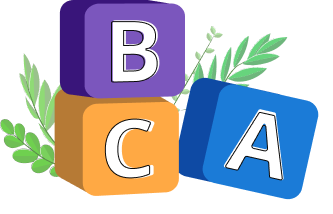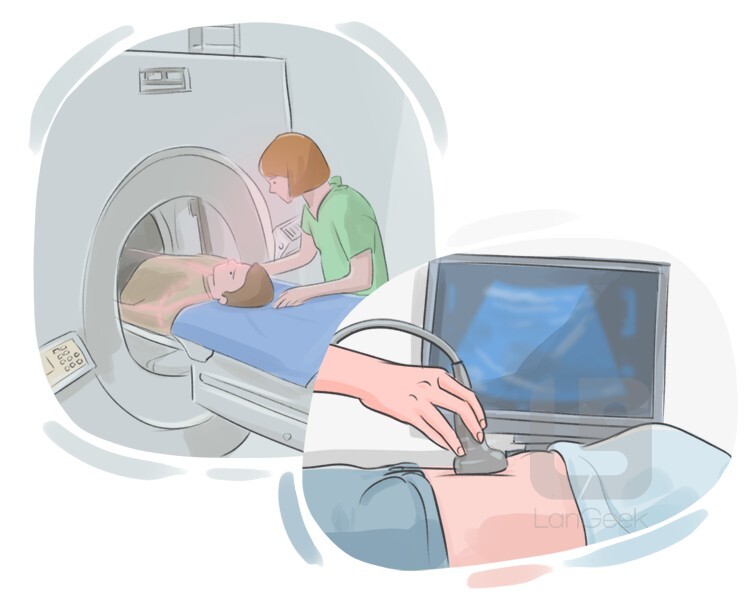

(चिकित्सा इमेजिंग उपकरण)
स्कैनर
a device used by doctors and physicians that produces an image of structures within the body on a computer screen
A scanner is a medical device used to create detailed images of the inside of the body. It works by producing different types of radiation, such as X-rays, magnetic fields, or ultrasound waves, depending on the specific type of scanner. These images help healthcare professionals diagnose and monitor conditions by providing clear visual information about organs, tissues, and bones. Scanners are essential tools in modern medicine for detecting abnormalities, planning treatments, and tracking the progress of diseases without the need for surgery or other similar procedures.
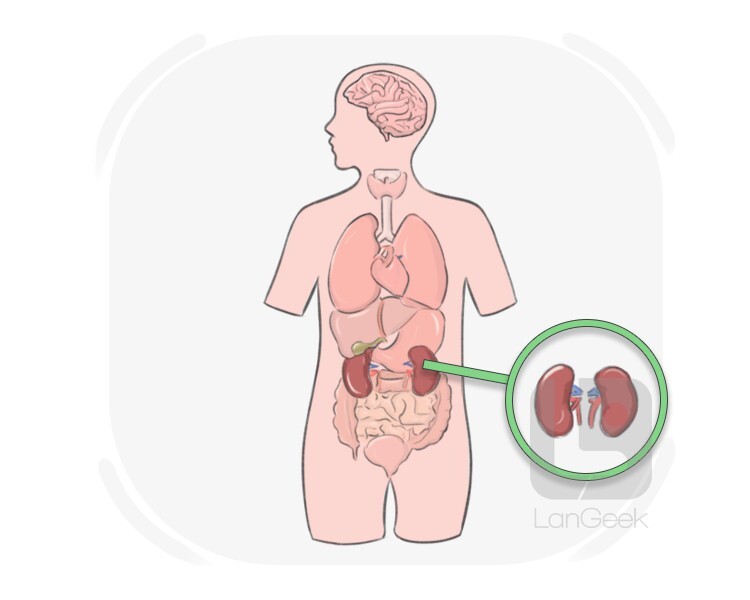

(वृक्क)
गुर्दा
each of the two bean-shaped organs in the lower back of the body that separate wastes from the blood and make urine
The kidney is a vital organ in the human body that plays a crucial role in maintaining overall health. They are responsible for filtering waste products and excess fluids from the blood, producing urine, and regulating various essential functions, such as electrolyte balance and blood pressure. The kidneys also participate in the production of hormones that help control red blood cell production and maintain bone health. Their bean-shaped structure, located in the back of the abdominal cavity, consists of millions of tiny filtering units called nephrons. Proper kidney function is essential for the body's overall homeostasis and well-being.
व्याकरण संबंधी जानकारी:

क्रांतिकारी
causing or involving a grand or fundamental change, particularly leading to major improvements

(परिवर्तन)
क्रांति
a drastic and far-reaching change in ways of thinking and behaving


(काल)
युग
a period of history marked by particular features or events


(उन्नति)
प्रगति
progress or improvement in a particular area

(क्रांतिकारी)
मौलिक
(of actions, ideas, etc.) very new and different from the norm

परंपरा
behavior and actions that most members of a society expect and consider appropriate

नैदानिक
related to identifying or determining the presence of an illness or problem by analyzing various symptoms or signs


(रोग का पता लगाना)
निदान करना
to find out the cause of a problem or disease that a person has by examining the symptoms
व्याकरण संबंधी जानकारी:


निदान
the identification of the nature and cause of an illness or other problem
Diagnosis is the process of identifying a disease or condition based on a patient's symptoms, medical history, and test results. It involves examining signs and symptoms and using various tests, such as blood tests, imaging scans, or physical examinations, to understand what is causing the problem. A correct diagnosis helps doctors decide on the best treatment plan and manage the patient’s health effectively.

(सीमित करना)
प्रतिबंधित करना
to confine someone to a specific activity, possession, or place
व्याकरण संबंधी जानकारी:

( सीमा)
प्रतिबंध
an act of limiting or restricting (as by regulation)


(छूत की बीमारी)
संक्रामक
(of a disease or condition) capable of transmitting from one person, organism, or object to another through direct or indirect contact


संक्रमण
a condition in which harmful germs, such as bacteria or viruses, invade the body and cause harm, leading to symptoms such as fever, pain, and swelling


(फैलाना)
संक्रमित करना
to transmit a disease to a person, animal, or plant
व्याकरण संबंधी जानकारी:
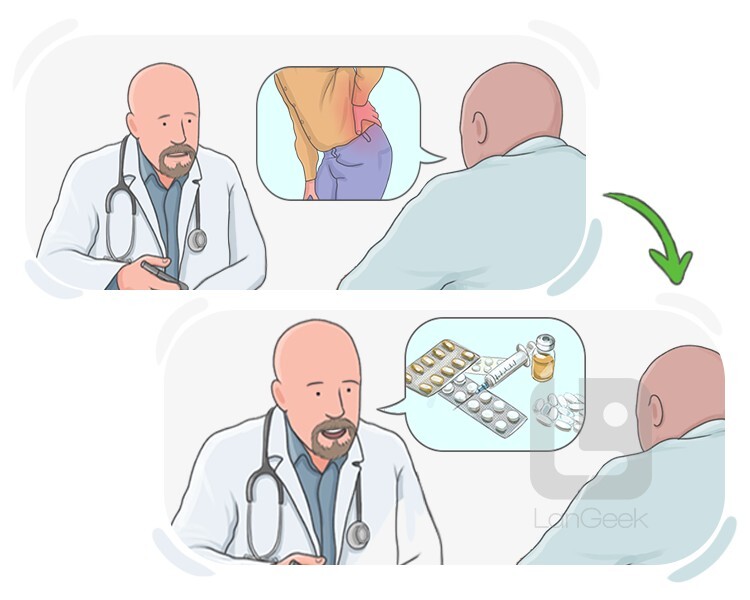

(दवा)
इलाज
a treatment or medication for a certain disease or injury


(ठीक करना)
इलाज करना
to make someone regain their health
व्याकरण संबंधी जानकारी:


टीका
a substance, often administered through needle injections, that stimulates the body's immune response against harmful diseases
A vaccine is a substance given to stimulate the body's immune system to protect against a particular disease. It typically has a small, weakened, or a non-active part of the virus or bacteria that causes the disease. When a person receives a vaccine, their immune system recognizes the foreign substance as a threat and produces antibodies to fight it. This process prepares the immune system to respond quickly if the person is exposed to the disease-causing organism in the future, preventing illness or reducing its intensity.
व्याकरण संबंधी जानकारी:


(प्रतिरक्षण)
टीकाकरण
the process or an act of introducing a vaccine into the body as a precaution against contracting a disease
Vaccination refers to the process of giving a vaccine to help the immune system develop protection against specific diseases. Vaccines typically contain a small, harmless piece of the virus or bacteria that causes the disease, which stimulates the immune system to recognize and fight the actual germs if it enters the body in the future. Vaccination is an important tool in preventing infectious diseases, reducing the spread of illnesses, and protecting public health. It can be given through injections, nasal sprays, or oral doses, depending on the vaccine.


टीका लगाना
to protect a person or an animal against a disease by giving them a preventive shot against specific diseases
व्याकरण संबंधी जानकारी:


(समाप्त करना)
उन्मूलन करना
to completely destroy something, particularly a problem or threat
व्याकरण संबंधी जानकारी:

(प्रतिबंधित)
सीमित
restricted or limited in space, area, or movement
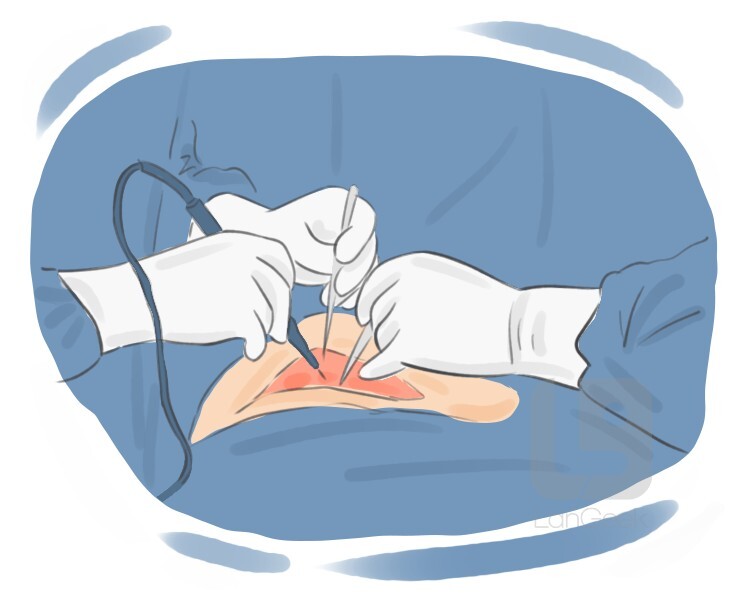

( हस्तक्षेप)
प्रक्रिया
an operation performed by medical professionals to diagnose, treat, etc. a medical condition or injury
A procedure is a specific method or set of actions taken to diagnose, treat, or manage a health condition. It can range from a simple test, like taking a blood sample, to more complex operations, such as surgery. Procedures are designed to achieve a particular medical goal, such as relieving symptoms, correcting a problem, or gaining information for diagnosis.
व्याकरण संबंधी जानकारी:


(अपराध दर)
दर
the number of times something changes or happens during a specific period of time

(बचाव)
उत्तरजीविता
the state in which a person manages to stay alive or strong despite dangers or difficulties
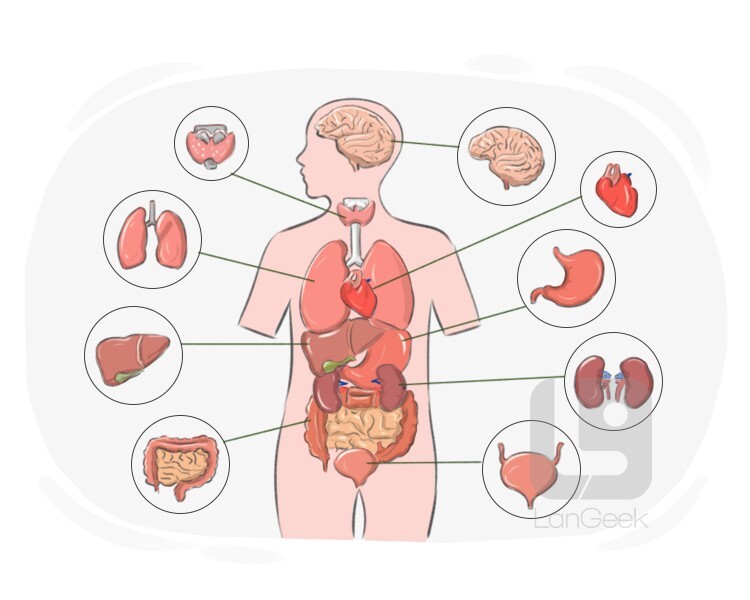

अंग
any vital part of the body which has a particular function
An organ is a distinct structure composed of different types of tissues that work together to perform specific functions. Organs are vital components of the body's systems and are responsible for carrying out essential physiological processes. Examples of organs in the human body include the heart, lungs, liver, kidneys, and brain. Each organ has a unique structure and function, and their coordinated activities contribute to the overall health and homeostasis of the body. Understanding the organization and function of organs is crucial for comprehending human biology and diagnosing and treating various medical conditions.
व्याकरण संबंधी जानकारी:

प्रत्यारोपण
a surgery in which an injured body part or organ is removed and is replaced with another person's

(अंग प्रत्यारोपण करना)
प्रत्यारोपण करना
to surgically remove an organ from someone's body and put it in someone else's body
व्याकरण संबंधी जानकारी:

(दानदाता)
दाता
(medicine) someone who provides biological materials for transplantation or medical procedures
A donor is a person who gives an organ, tissue, or blood to another person in need, such as those undergoing transplants or needing blood transfers. This can include living donors, who give a part of their organ or tissue while they are alive, or dead donors, who provide organs or tissues after they have died. Donors have a crucial role in treatments and transplants that can save lives or improve health.


(योग्य बनाना)
सक्षम बनाना
to give someone or something the means or ability to do something
व्याकरण संबंधी जानकारी:


(जारी रखना)
फिर से शुरू करना
to continue again after an interruption
व्याकरण संबंधी जानकारी:


विटामिन
natural substances that are found in food, which the body needs in small amounts to remain healthy, such as vitamin A, B, etc.
Vitamins are essential nutrients that the body needs in small amounts to function properly. They play crucial roles in various bodily processes, including supporting growth, maintaining healthy skin, boosting immunity, and assisting in metabolism. There are 13 essential vitamins, each with its own specific functions and sources. These include vitamins A, B, which includes several individual B vitamins, C, D, E, and K. Vitamins are obtained through the diet, primarily from fruits, vegetables, whole grains, dairy products, and meats.

(एस्कॉर्बिक एसिड)
विटामिन सी
a water-soluble vitamin essential for human nutrition, known for its antioxidant properties, supporting immune function, and collagen production
Vitamin C, also known as ascorbic acid, is a water-soluble vitamin that plays several important roles in the body. It is a powerful antioxidant, helping to protect cells from damage caused by harmful molecules called free radicals. Vitamin C is also essential for the growth and repair of tissues, wound healing, and the maintenance of healthy skin, blood vessels, and bones. Additionally, it supports the immune system and helps the body absorb iron from plant-based foods. Good dietary sources of vitamin C include citrus fruits, such as oranges and lemons, strawberries, kiwi, bell peppers, broccoli, and tomatoes.

(सूर्य विटामिन)
विटामिन डी
a fat-soluble vitamin crucial for human nutrition, essential for calcium absorption, bone health, and immune system support
Vitamin D is an essential nutrient that plays a crucial role in maintaining bone health by helping the body absorb calcium. It also supports immune function, muscle health, and overall well-being. The body can produce vitamin D when the skin is exposed to sunlight, but it can also be obtained from foods such as fish, fortified dairy products, and egg yolks, as well as supplements. Getting enough vitamin D is important to prevent conditions like rickets in children and osteoporosis in adults, ensuring strong bones and a healthy immune system.


खनिज
a solid, naturally occurring substance with a specific chemical composition, typically found in the earth's crust, such as gold, copper, etc.

(खनिज पदार्थ)
खनिज
a solid and natural substance that is not produced in the body of living beings but its intake is necessary to remain healthy
Minerals are essential nutrients that the body needs in small amounts to function properly. They play crucial roles in various bodily processes, including building strong bones and teeth, controlling the amount of water in the body, supporting nerve function, and maintaining healthy metabolism. There are two main categories of minerals: macro-minerals, which are needed in larger quantities, and trace minerals, which are required in smaller amounts. Common macro-minerals include calcium, magnesium, phosphorus, potassium, sodium, and chloride, while examples of trace minerals include iron, zinc, copper, selenium, iodine, and chromium. These minerals are obtained through the diet, primarily from foods like fruits, vegetables, whole grains, nuts, seeds, dairy products, and lean meats.

(अनुपूरक)
पूरक
an additional element that boosts the effectiveness or functionality of something


शल्य चिकित्सा
a medical practice that involves cutting open a body part in order to repair, remove, etc. an organ
Surgery is a medical procedure where a doctor makes a cut to treat or remove parts of the body, repair injuries, or address health issues. It can involve various techniques, such as cutting, stitching, or using specialized tools, and is often performed in a hospital or surgical center. Surgery can be planned in advance or done as an emergency procedure and usually requires anesthesia to ensure the patient does not feel pain during the operation.


ऑपरेशन
a medical process in which a part of body is cut open to repair or remove a damaged organ
An operation is a medical procedure where a surgeon cuts into the body to treat a disease, injury, or other health condition. Operations can be done to remove tumors, repair broken bones, or perform transplants, among other things. They are usually performed in hospitals or surgical centers and can vary in complexity from minor procedures to major surgeries.


(शल्य चिकित्सा करना)
ऑपरेट करना
to cut open a part of the body in order to repair or remove a damaged organ
व्याकरण संबंधी जानकारी:

(शल्य कक्ष)
ऑपरेशन थियेटर
a room in a hospital where surgical operations are performed
व्याकरण संबंधी जानकारी:


(शल्य चिकित्सक)
सर्जन
a doctor who performs medical operation
A surgeon is a medical doctor who specializes in performing operations, known as surgeries, to treat injuries, diseases, and deformities. Surgeons are trained to carry out a wide range of procedures, from minor to complex operations, often focusing on specific fields such as general surgery, orthopedic surgery, neurosurgery, or cardiovascular surgery. Surgeries typically involve making cuts in a patient's body to manipulate tissues for repair, removal, or replacement of damaged areas. Surgeons also provide care before and after surgery, making sure that patients are well-prepared for the operation and are properly recovering afterward.


(सर्जिकल)
शल्य
related to or involving medical procedures that involve making incisions in the body to treat injuries, diseases, or deformities

(नष्ट कर देना)
मिटा देना
to completely remove or destroy something so that it no longer exists
व्याकरण संबंधी जानकारी:
बधाई हो! !
आपने 45 से undefined शब्द सीखे हैं। शिक्षा और शब्दावली की समीक्षा म
समीक्षा करें
फ्लैशकार्ड्स
वर्तनी
प्रश्नोत्तरी
